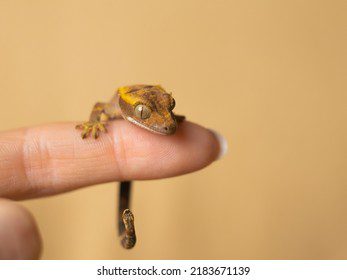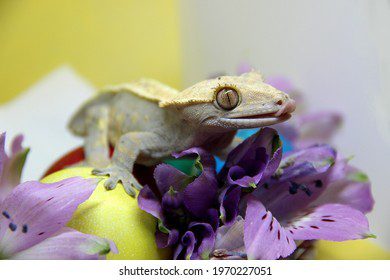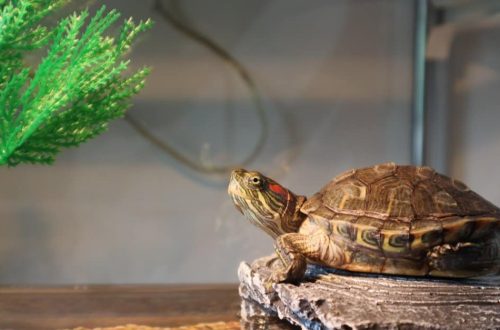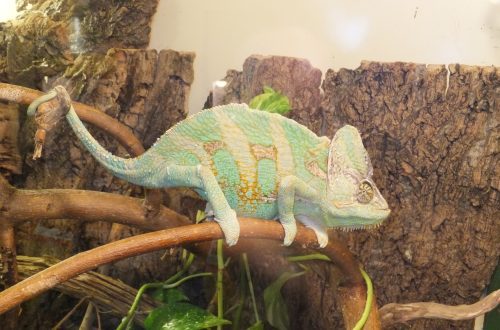
Ciliated banana-eaters (Rhacodactylus ciliatus)
The ciliated banana-eater (Rhacodactylus ciliatus) is a gecko on the island of New Caledonia. Their main and distinctive feature is spiked scales around the eyes, similar to eyelashes, and the same scales along the edges of the head, forming the so-called “crown” or crest. On English-language resources, for this they are called crested geckos (crested gecko). Well, how can you not fall in love with these eyes? 🙂
There are many color morphs of banana eaters. We most often sell normals and the fire morph (with a light stripe on the back).
Conditions of detention
Banana eaters need a vertical terrarium with a background and lots of twigs for climbing and hiding. The size of the terrarium for one adult gecko is from 30x30x45, for a group – from 45x45x60. Babies can be kept in smaller volumes or in suitable containers.
Temperature: background daytime 24-27 °C (room temperature), at the heating point – 30-32 °C. The background night temperature is 21-24 °С. Background temperatures above 28°C can cause stress, dehydration and possibly even death. Heating preferably with a lamp (with a protective grid). There should be good branches at various levels below the hotspot so that the gecko can choose the best spot.
Ultraviolet: The literature says that ultraviolet is not necessary, but personally I have encountered convulsions in geckos, which disappeared after the installation of a UV lamp. Quite weak (ReptiGlo 5.0 will do), because animals are nocturnal.
Humidity: from 50%. Mist the terrarium in the morning and evening, mist the soil well to keep the moisture level (a pump sprayer will be handy for this purpose) or purchase some kind of device to maintain humidity.
Soil: Coconut (not peat), sphagnum, gravel. Ordinary napkins will also work (geckos don’t go down to the bottom very often, preferring branches), but on the condition that they are changed often, because. due to humidity, they quickly turn into something untidy. If you have a breeding group of geckos, the soil must be checked for eggs, females like to hide them in secluded corners, and even a special wet chamber does not always keep them from this.
Features of behavior
Banano-eaters are nocturnal geckos, they are active in the evening hours and more often after the lights are turned off. Easily tamed by hand. Quite active, great jumpers, literally gliding from branch to branch or from your shoulder to the floor – so be careful.
In case of severe stress or injury, the tail can be dropped. Unfortunately, the tail of these geckos does not grow back, but its absence does not cause visible discomfort to the animals.
Feeding
Omnivorous – eat insects, small invertebrates and mammals, fruits, fruits and berries, succulent shoots of plants, flowers, eat nectar and pollen from buds. At home, they feed crickets (they prefer them to cockroaches), cockroaches, other insects, fruit purees with vitamin supplements.
You should be careful with fruits: banana-eaters do not digest citric acid in large quantities – therefore, no lemons, oranges and other citrus fruits. Suitable fruits: peaches, apricots, mango, banana (but despite the name – you should not abuse bananas), soft pears, sweet apples (not a lot). Life hack – ready-made baby puree from the listed fruits, but be sure to make sure that there are no additives: cottage cheese, starch, cereals, and sugar – only fruits. Well, after the gecko masters a couple of spoons – a jar and finish eating it yourself is not shameful 🙂
You can make your own fruit puree by mixing fruit with vitamins in a blender and freezing in the freezer in ice molds.
Small geckos are offered a little food every day, adults are fed once every 2-3 days. In addition to insects and mashed potatoes, you can order a special ready-made food that is popular abroad: Repashy Superfood. But I do not consider it to be something super necessary, except that it is convenient to store and give.
Water in a small drinking bowl should be in the terrarium, in addition, geckos love to lick off water droplets after spraying the terrarium. Banana eaters love to lick mashed potatoes off their hands, so you can turn feeding into a pleasant and cute ritual.
Sex determination and breeding
Sex in banana-eaters can be determined starting from 4-5 months. Males have pronounced hemipenis bulges, while females do not have them. However, I have often come across cases of the sudden appearance of male characteristics in a seemingly female, so be on the lookout. Banana-eater females are much rarer than males.
There are also manuals for determining sex with looking at and trying to detect prianal pores (see photo), but I never succeeded, even with the help of a super large zoom from a powerful camera, and the alleged female ended up being a very, very significant male 🙂
If you are planning to breed, then you need to collect a group of one male and 2-3 females, or get two terrariums and plant geckos only for mating. The male will terrorize one female, may even injure or bring to stress or loss of the tail. Several males cannot be kept together.
Mating takes place at night and is sometimes quite noisy 🙂 Geckos make quacking sounds. If everything went well, then the female will lay several clutches (3-4 on average) of 2 eggs. Eggs are incubated in vermiculite or perlite at 22-27°C for 55-75 days. Newborn geckos are seated in individual containers and fed cricket “dust”. It is advisable not to try to feed them with your hands and pick them up in general – at least 2 weeks, babies can drop their tails due to stress.
So you already have a set of initial knowledge for keeping these wonderful geckos, you just have to get yourself a pocket dragon! 🙂
Author – Alisa Gagarinova





